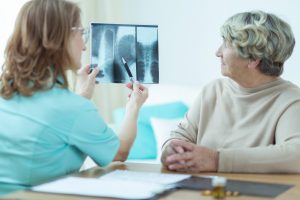 A new study has found that many patients at risk for osteoporosis and bone fractures do not receive proper evaluation and subsequent treatment. Current guidelines suggest that all postmenopausal women over the age of 50 be evaluated for osteoporosis which entails a detailed medical examination and clinical fracture risk assessment.
A new study has found that many patients at risk for osteoporosis and bone fractures do not receive proper evaluation and subsequent treatment. Current guidelines suggest that all postmenopausal women over the age of 50 be evaluated for osteoporosis which entails a detailed medical examination and clinical fracture risk assessment.
Women are particularly susceptible to osteoporosis as their bones are thinner, and their risk rises even further with menopause as a result of loss of estrogen.
Advertisement
Dr. Pauline M. Camacho developed the guidelines for osteoporosis screening. The recommendations are graded from A to D, with those graded as A having the most convincing evidence to support the guidelines.
- Provide counseling on reducing risk of falls, particularly among the elderly.
- Strongly recommend medications for patients with osteopenia or low bone mass and a history of a fragility fracture of the hip or spine. (Osteopenia refers to bone density that is lower than normal peak density but not low enough to be classified as osteoporosis. A fragility fracture is a fracture that results from a fall from a standing height or less.)
- Medications that reduce the risk of fractures include alendronate (Fosamax®), risedronate (Actonel®), zoledronic acid (Zometa®), and denosumab (Prolia® and Xgeva®).
- Treatment with teriparatide (Forteo®) should be limited to two years.
- Successful treatment of osteoporosis is defined as stable or increasing bone mineral density, with no evidence of new fractures or fracture progression.
The guidelines state, “Despite these significant costs, fewer than one in four women aged 67 years or older with an osteoporosis-related fracture undergoes bone density measurement or begins osteoporosis treatment.”
Risk factors for osteoporosis include older age, low body weight, family history, smoking, early menopause, and high alcohol intake.
The guidelines concluded, “Further study is needed to determine the most effective means of communicating benefit and risk in osteoporosis management. The best available evidence at this time suggests that communication skills can be learned, decision aids may be helpful, and that shared decision-making may improve clinical outcomes.”
